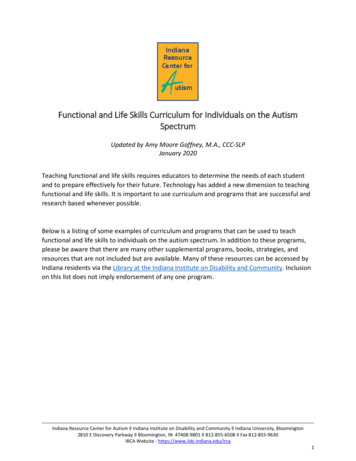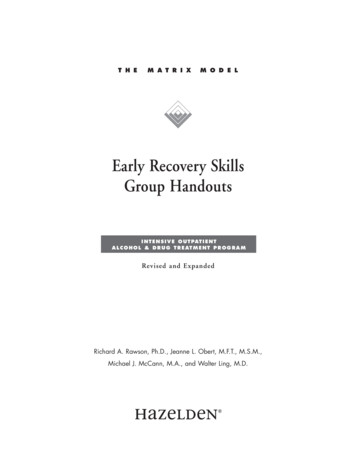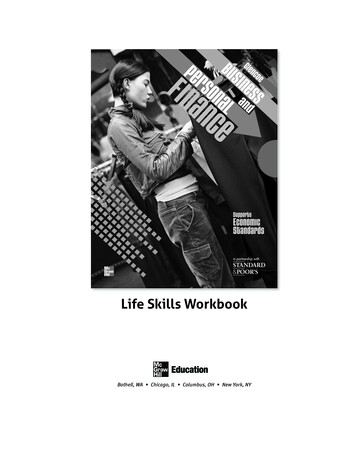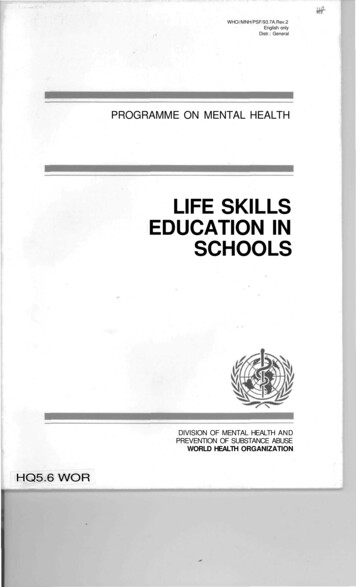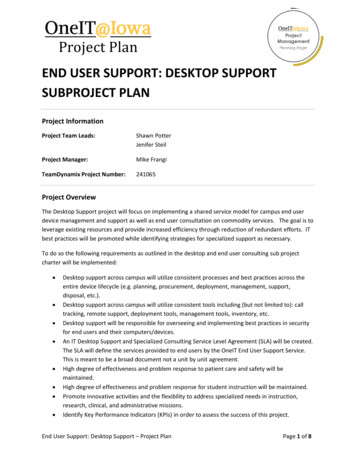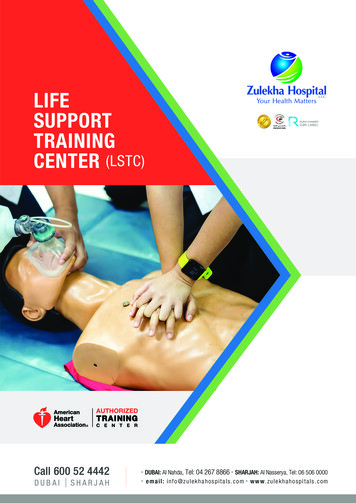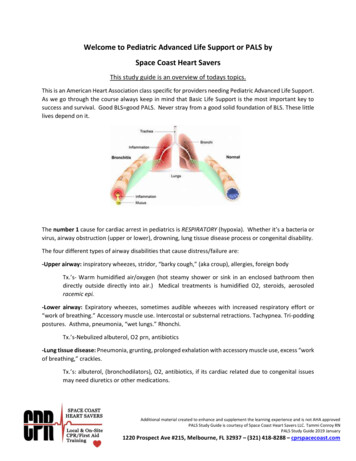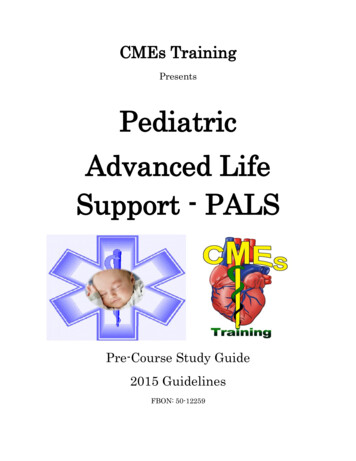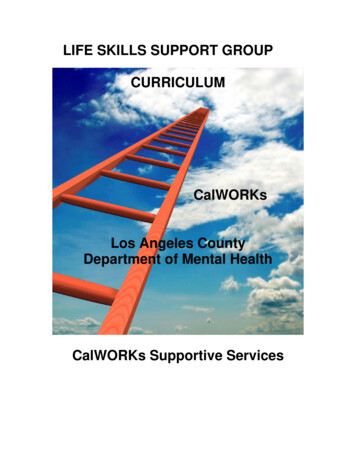
Transcription
LIFE SKILLS SUPPORT GROUPCURRICULUMCalWORKsLos Angeles CountyDepartment of Mental HealthCalWORKs Supportive Services
SUCCESS LADDERMy Career GoalCAREEREDUCATIONEntry Level Job
LIFE SKILLS SUPPORT GROUPCURRICULUMDeveloped byCalWORKs Program AdministrationCounty of Los Angeles Department of Mental Health
LIFE SKILLS SUPPORT GROUPCURRICULUMCONTENTSPurposeixThe Right Frame of MindModule 1A:Attitude . 1Module1B:Motivation Module 1C:Responsibility . 94How to Handle the Tough StuffModule 2A:Conflict Resolution .14Module 2B:Dealing with Anger . 18Module 2C:Stress Reduction . 23How to Put Your Best Foot ForwardModule 3A:Communication/Non-Verbal . 30Module 3B:Communication/Verbal 35Module 3C:Communication/Interview .39
contentsThe Nuts and BoltsModule 4A:Money Management 43Module 4B:Time Management 48Module 4C:Decision Making . 53The Balancing ActModule 5A:Setting Priorities 58Module 5B:Home/Work/School .62Module 5C:Family/Friends/Myself 67Time to Act/Stop ProcrastinatingModule 6A:My Personal Plan . 73Module 6B:Design a Resume .76Module 6C:Bring in the Speakers . 78AppendixInstructor’s Guide to the Six Modules . 79Suggested Readings .98
LIFE SKILLS SUPPORT GROUPCURRICULUMPURPOSE:CalWORKs Life Skills Support Groups combine the objectives of removingmental health barriers to employment with exercises that promote practicaloutcomes. Participants will learn coping strategies to deal with theiremotional concerns, and gain knowledge about the culture of the workenvironment. Personal strengths will be identified in dealing with stressrelated issues. Participants can expect to become empowered to pursueeducational/employment goals while improving in the area of general lifeskills.This will be an open-entry and open-exit group, which will meet two hoursevery week for six weeks.The target population is CalWORKs participants who are identified by theirtreatment provider as not being fully ready for the mainstream WtWprogram activities, but are ready to work on life skills that may betterprepare them for employment.ix
The Right Frame of Mind
MODULE 1ALIFE SKILLS SUPPORT GROUPTHE RIGHT FRAME OF MINDATTITUDEGOAL:This module is designed to help participants overcomebarriers in thinking that prevent them from movingforward. Participants will learn to identify and correctnegative views that lead to unproductive behavior.OBJECTIVES:Participants will be able to: recognize negative thinking patterns understand how thinking is related to behavior have more control over negative behaviorMATERIALS:Handouts: Attitude is Key, Examples of NegativeThoughts*This module selection (attitude) requires an LMHA Staff to conduct group1
Module 1AATTITUDE IS KEY!AS A MAN THINKETH SO IS HEIn order to gain more control over our emotions and behavior, we can becomemore aware of the negative destructive thoughts that enter our minds almosthabitually. These negative thoughts have the power to control how we feel andhow we process information in deciding how to behave.The good news is that while we typically cannot control the way we feel about aperson or a matter, we can control our thoughts! This becomes significant whenwe need to change the way we respond to certain situations.The behaviors and feelings that we most often want to change are the ones thathave negative consequences tied to them. High intensity feelings like rage, envy,sadness, and guilt can be debilitating, particularly if experienced often.Let’s look at an example where our feelings can change in response to a change inour thinking pattern.EXAMPLE:A neighborhood fire breaks out and three family homes areburned down. There was no loss of life, but one woman wholost her home grieved so much she ended up in the hospital forstress-related illness.What happened to the other homeowners? How did theymanage to survive the fire without needing medical care?In this narration, the other fire victims were relieved that therewas no loss of life and that everyone in their family was safe.While they had normal feelings of grief and loss they managedto look toward building their lives again.2
Module 1AEXAMPLES OF NEGATIVE THOUGHTS ANDHOW THEY MAKE YOU FEEL AND ACTPlease add examples of negative thoughts and their consequences:Negative thoughts/attitude1.2.3.4.5.6.7.8.9.10.I am stupidI can’t do anything rightI must be perfectI can’t trust peopleI am afraidFeelingsBehaviorSadnessOverwhelmedTense/No JoySuspiciousFearAvoid learningWon’t tryLimitingAvoid othersWon’t live life3
MODULE 1BLIFE SKILLS SUPPORT GROUPTHE RIGHT FRAME OF MINDMOTIVATIONGOALS:This module helps participants get started toward takingpositive actions in their life. They will be able to set careerrelated goals and reward themselves for making small steps.OBJECTIVES:Participants will be able to: identify barriers and concerns that prevent taking action discover meaning in their life—what drives them to want toimprove set self-reward system for each accomplishmentMATERIALS:Handouts: Motivation, Things That Interfere, My Life HasMeaning, Things I Really Enjoy4
Module 1BMOTIVATIONThere are just some things that are hard to get motivated for, things likehouse cleaning, shopping, paying bills etc. Yet motivation is the woodthat sets our lives aflame with meaning and focus. It keeps us goingwhen the going gets tough. It “turns us on!” Have you thought aboutthe things, people, places, situations that motivate you? Motivation isbest when it comes from inside you, and you don’t have to havesomeone else motivating you. You do it because you want to. Theremay be only a few things that motivate you, but what ever they are theyare powerful igniters. If you can find out what motivates a child forexample, you can get that child to perform duties that otherwise wouldbe difficult. If you are no longer motivated to act or accomplishsomething in your life, you may be discouraged, tired, or depressed. Beencouraged, it only takes a small fire to kindle a dream or pursuit! Onceyou tap into that thing that stirs your interests, and desires, you will findthat it stayed there waiting on you. Just pick it up and start off whereyou left off.5
MODULE 1BTHINGS THAT INTERFERE WITH MY GOALS1.I have trouble taking the first step.2.I need childcare.3.I did not finish high school.4.I am too old to go back to school.5.I don’t know where to start.6.I don’t have support.7.I need clothes.8.I don’t know salary to ask for.9.I don’t have transportation.10.I lack basic work skills.11.I had a bad experience with my last job.12.I am not physically able to work.13.I want to wait until my kids are in school.14.Other .6
MODULE 1BMY LIFE HAS MEANING WHENI CAN .1.2.3.4.5.I HAVE .1.2.3.4.5.I WOULD BE MORE SATISFIED WITH MY LIFE IFI COULD .1.2.3.4.5.7
MODULE 1BTHINGS I REALLY ENJOY DOING1.2.3.4.5.IF I HAD TO REWARD MYSELF FOR DOINGSOMETHING WELLI WOULD 1.2.3.4.5.8
MODULE 1CLIFE SKILLS SUPPORT GROUPTHE RIGHT FRAME OF MINDRESPONSIBILITYGOALS:This module helps participants gain a sense of controlover life outcomes by making informed choices. Theywill learn the value of admitting past mistakes. Theconsequences of decision-making will be highlighted.OBJECTIVES:Participants will be able to: identify barriers to achieving past goals and come upwith new remedies become more comfortable in making decisions accept credit and rewards for what is done well whileadmitting mistakesMATERIALS:Handouts: Responsibility, Barriers in MyPast/Present, Making Better Choices9
Module 1CRESPONSIBILITYHave you noticed that few people want to take responsibility thesedays? There is trash on the front side walk. Who picks it up? Youoften hear, it’s not my job! No, it’s not your job, but you live thereand it may reflect poorly on you. Not taking responsibility forwhat goes undone is one thing, but if you don’t take responsibilityfor your life decisions you will pay. Just the thought of taking onone more responsibility is perhaps tiring to most people who arealready over stressed with family and work duties. But, there isone positive way to think about it: being more responsible can alsomean taking more control over what happens to you. The moreyou can determine the positive things in your life the more you willhave them. If you leave control in the hands of someone else, or inthe hands of the “system,” you will no doubt find the outcome maynot be what you want. So one way of getting more of what youwant from life is to make sure that the outcome turns out in yourfavor. Take the responsibility!10
Module 1CBARRIERS IN MY PASTList some of the things, situations, or people that have hindered you in thepast from achieving your goals.1.2.3.4.BARRIERS IN MY PRESENTThere are things, situations or people that are currently interfering with youreaching your goals.1.2.3.4.11
MODULE 1C: Conti.MAKING BETTER CHOICESMost mistakes in the past can be attributed to making poor choices. Thegood thing about past failures is the opportunity to learn from them. Welearn what not to do, who to trust and why. We also learn that more help orinformation may be needed next time.SOME THINGS I HAVE LEARNED FROM PASTMISTAKES1.2.3.4.5.WHEN I SUCCEED AT A GOAL I PLAN TO REWARDMYSELF BY1.2.3.12
Module 1C: Conti.ADDRESSING SUBSTANCE USE/ABUSE ISSUESThe art of making good choices and informed decisions is not aneasy task. It takes time and thought. One has to consider how ouractions affect others. Substance use alters one’s ability to processinformation and make responsible action plans. Often things doneunder the influence of drugs or alcohol can have long term effects.THINGS THAT I REGRET DONE UNDER THE INFLUENCE OFDRUGS OR ALCOHOL1.2.3.THINGS I CAN DO OR SAY TO TAKE RESPONSIBILITY FOR MYACTIONS UNDER THE INFLUENCE1.2.3.13
How to Handle the Tough Stuff
MODULE 2ALIFESKILLS SUPPORT GROUPHOW TO HANDLE THE TOUGH STUFFCONFLICT RESOLUTIONGOAL:This module is designed to help participants reduceconflict in relationships. They will learn techniques tohelp negotiate what they want.OBJECTIVES:Participants will be able to: recognize how words and behavior can impact others learn at least one effective technique for managingnegative behaviors develop strategies for dealing with difficult peopleand situationsMATERIALS:Handouts: Techniques For Managing NegativeBehavior, Making “I” statements,” My Personal Strategyfor Dealing With Difficult ”14
MODULE 2ATECHNIQUES FOR MANAGING NEGATIVEBEHAVIORWe can best manage our behavior in conflicts by exercising some of thefollowing techniques:1. Try to focus on the facts and figure out what the other person actuallysaid or did.2. Don’t talk before you are prepared to respond in a reasonable way.3. Demonstrate continued good will by saying that you want to workthings out.4. Make sure that you have given your side and opinion accurately.5. If necessary ask a mutually respected person to mediate.6. Stay flexible; be open to change your mind after you hear more fromthe other side.7. Don’t fight the small stuff; figure out if the issue is important enoughto pursue resolution.8. Set another time to continue the talks if you feel you are not beingunderstood.9. Don’t involve others who have nothing to do with the conflict.10. Try not to over rehearse your anger before addressing the issue.15
Module 2AMAKING “I” STATEMENTSThe use of “I” statements (owning your own thoughts) helps to avoidcriticizing or placing blame on others. Taking responsibility for what weunderstand, even if we are wrong, reduces defensiveness in those we areinteracting with. Below are examples of “I” statements. The first statementis less inflammatory than the second statement. Practice making more “I”statements in your interactions.Examples:1. I would like to talk more.You don’t let me talk!2. I am bothered by your being late.You come in here late all of the time!3. I am concerned about your drinking habits.You drink too much!4. I worry that something may happen to you when you stay out late.You could care less how I feel when you stay out late!5. I am angry when I feel that you don’t care.You don’t care about me!6. I am disappointed over not receiving that last promotion.You did not give me the promotion I wanted!7. I am afraid that I won’t be able to please you.No one will ever be able to please you!16
MODULE 2AMY PERSONAL STRATEGY FOR DEALING WITHDIFFICULT PEOPLE AND DIFFICULTSITUATIONSThink of a situation or person that you are dealing with or have dealt withthat has been problematic. How would you deal with the issue based uponwhat you have learned from this module?The problemWhat not to do17Ways to resolve
MODULE 2BLIFESKILLS SUPPORT GROUPHOW TO HANDLE THE TOUGH STUFFDEALING WITH ANGERGOAL:This module is designed to deal with anger before it getsout of control. Participants should be prepared toidentify areas of sensitivity that tend to trigger an angryresponse.OBJECTIVES:Participants will be able to: MATERIALS:identify the physical effects of anger on the bodysee things from the view of othersknow when to remove oneself from the scenereframe from over-personalizingHandouts: Anger, Make a list of Times When Anger GotYou in Trouble, What Makes You Angry, Things I CanDo to Cope Better18
Module 2BANGERAnger is an emotion that helps to preserve the species. In years past, whenhumans had to live beside wild animals and learn to survive in a morehostile physical environment, the arousal of certain emotions like anger andfear was critical to survival. When strong emotions are aroused, thesympathetic nervous system is activated. It is also known as the “fight orflight” response. In the case of fear, our human biology was programmed torun from harm, and in the case of anger, we were programmed to fight.Although we no longer have to exist in hostile physical environments, theseintense arousal signals may still dominate our being. The problem is, aresponse of “fight or flight,” may not be the appropriate one in the civilizedworld, and indeed, in the case of “fight,” may get you in big trouble! Sohow do we manage these intense emotional responses that our old biology isprogrammed for?Managing anger is an important and necessary skill in coping with lifeevents. We can no longer just run away or fight our way through athreatening situation. For some, anger is a learned response in dealing withstress. When anger becomes a habitual response, it is very difficult tochange this pattern of behavior. Some times it requires outside help fromprofessionals in the mental health field. The good news is that this behaviorpattern can change by learning better coping skills. Below are some tips andgeneral guidelines for dealing with anger: Deliberately choose to remain calm by thinking rather thanresponding. Don’t hold in frustrations until they build up. Speak up in an assertivemanner to get your point across. If you feel overwhelmed, remove yourself from the scene and returnto the matter when you feel more in control. Try to build up reserves by sleeping and eating well and doing thingsthat you enjoy.19
Module 2BMAKE A LIST OF TIMES WHEN ANGER GOT YOUIN TROUBLEWHEN YOU SAID OR DID THINGSTHAT YOU NOW REGRETIn pairs discuss the situation:Include who the person was. Describe the situation and what you said ordid. What was the reaction or consequence from your anger? Why do youregret what happenedPERSONSITUATIONOUTCOME1.23.4.20REGRET
Module 2BWHAT MAKES YOU ANGRY?List Your Triggers:1.2.3.4.5.6.7.8.21
Module 2BTHINGS I CAN DO OR CHANGE TO COPE BETTERWITH MY ANGER1.2.3.4.5.6.22
MODULE 2CLIFESKILLS SUPPORT GROUPHOW TO HANDLE THE TOUGH STUFFSTRESS REDUCTIONGOAL:This module is designed to help participants deal withstress in their daily living. They will learn stressreduction techniques that meet their personal style andcomfort.OBJECTIVES:Participants will be able to: MATERIAL:list potential areas of stress in their liveslearn how to use relaxation techniquesdevelop a healthy eating and exercise planidentify possible supports in their environmentHandouts: Stress Reduction, Relaxation, Exercise, EatingRight, Eating Right Reduces Stress, Things To Put In MyStress-Quake Bag23
Module 2CSTRESS REDUCTIONIn today’s world who has been able to escape the effects of stress? Perhapsthere are some good things to say about stress, but one has to really thinkhard to come up with it. One thing we know that when we are under stress,it sure feels good when the stress is relieved! The problem is, it goes awayto return again another day. Life on the planet inevitably means we have todeal with stress. What matters then, is how we chose to deal with it. Yes,we have some choice. We can let it grow bigger, by not attending to it, andend up with more stress, or we can tackle it before it escalates.There are a number of things we can do to prepare for stress and navigatethrough it once it is upon us. Preparing for stressful times may be as simpleas having an earthquake bag prepared. Instead of an earthquake, we arepreparing for a stress quake. What do we put in the bag? Perhaps we shouldstart with things that have a calming effect upon you. How about a niceluxury bath with everything arranged and ready to be pulled out whenneeded? You could have your favorite magazines ready for that time whenyou don’t want to think about the problems anymore and you just want tofade into a good book or magazine. Put that in the bag. Another suggestionwould be to find your favorite photos and have them ready to pull out andenjoy in the quiet of an evening. These can bring fond memories of a timeperhaps less stressful. There may be friends that are soothing and able tooffer a good word, or sound advice; put a reminder of that person’stelephone number in your bag. There must be more things you can think ofthat helps to settle your nerves, during stressful times. Jot it down and placein your stress-quake bag for times of emergencies. Mark “open with care.”Traditionally, we know that there are relaxation and breathing exercises thatalso help with stress reduction. Don’t forget the part that exercise plays inthe form of a walk. Lastly, eating right can us build reserves when ourbodies are tired or weary. There are things to do to combat stress, and justknowing that somehow feels good. To not do anything, is a poor choice.24
Module 2CRELAXATIONWe know that it is good for us to take time to relax, but weoften don’t know how to go about it if we have only a fewprecious minutes during the day. When we feel stressed, itis good to know some ways of relaxing. A good relaxationexercise is designed to help our bodies relax and reducestress. Below, is an exercise of relaxation that can be doneat work or when you can catch a few minutes in your day.Breathing:It is important to breathe fully, from your stomach andnot from your chest. In order to make sure you rarebreathing from your stomach, place one hand on yourstomach and the other on your chest. Notice where yourbreathing originates; begin deep breathing exercises fromthe stomach.Loosen Muscles: We may not be aware of muscle tightness in various partsof our bodies. In order to increase awareness and toknow how to loosen tight muscles, it is recommendedthat we first tighten each muscle and then release themuscle.Relax The Mind: It is helpful to take your mind off the stressors that youmay be facing by relaxing your thoughts. It is typicallyrecommended that you concentrate on a pleasant scene,one that is soothing and relaxing. Take a few minutes toconcentrate on this positive image.25
MODULE 2CEXERCISEQuestions to answer before you begin:(1): Think of different ways you wou
program activities, but are ready to work on life skills that may better prepare them for employment. The Right Frame of Mind . 1 MODULE 1A LIFE SKILLS SUPPORT GROUP THE RIGHT FRAME OF MIND ATTITUDE GO
